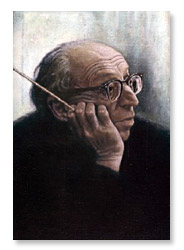 |
| Nosferatu |
Copland went on to temper his early dissonant writing in his later popular ballets Billy The Kid, Rodeo, and Appalachian Spring, but Grohg has dissonance and elements of American jazz, keeping with Copland's earlier style. As Copland was not commissioned to write the work, the only performance it got was a four-handed piano version privately played by Copland and Boulanger. The score was revised in 1932, but remained unperformed until the 1932 revision was found in the Library of Congress. The work was first performed in 1992.
The work is played without pause but is divided into six sections:
1) Introduction, Cortège and Entrance of Grohg - A slow introduction, followed by the bearers of coffins. Copland brings the dance of the coffin bearers to a climax as Grohg the Sorcerer enters and the dancers pay homage to the sorcerer.
2) Dance Of The Adolescent - Grohg revives the corpse of an adolescent who becomes terrified by Grohg. The adolescent is struck down by the sorcerer.
3) Dance Of The Opium Eater - Grohg next revives the corpse of an opium addict. The addict dances to a jazzy tune, and Grohg has pity on the addict and removes the magic that brought him back to life.
4) Dance Of The Streetwalker - The corpse of a streetwalker is revived and she does a dance that impassions Grohg. He tries to embrace her, there is a struggle.
5) Grohg Imagines The Corpses Are Mocking Him - Grohg begins to hallucinate and imagines the corpses are mocking him. He joins in the dance of the corpses. Chaos ensues, and Grohg hoists the Streetwalker over his head and throws her into the crowd.
6) Illumination And Disappearance of Grohg - The stage turns dark save for a light focused on Grohg's head, and he slowly disappears to music that echos back to the beginning.


A great ballet!
ReplyDelete